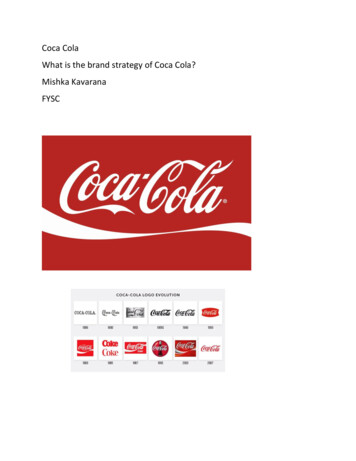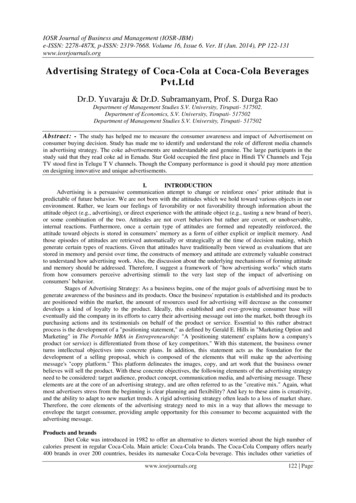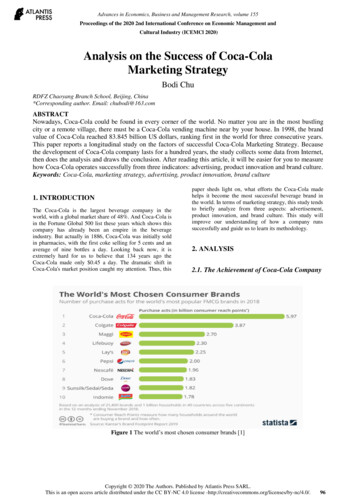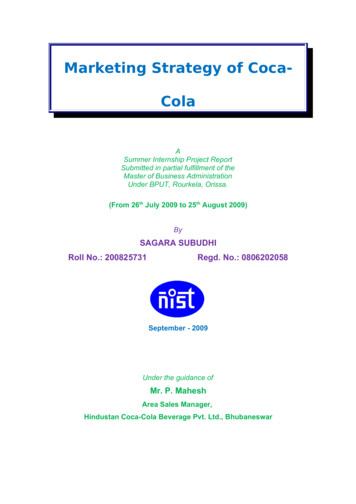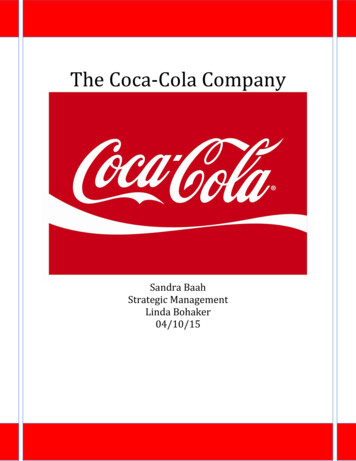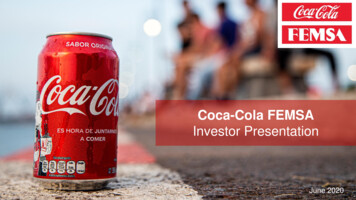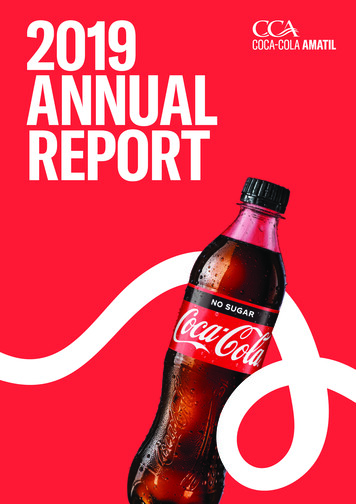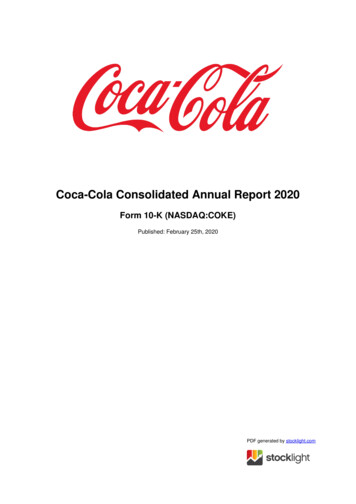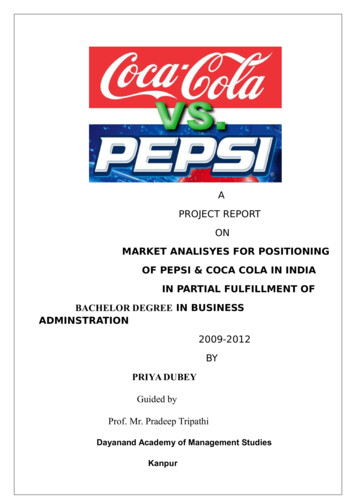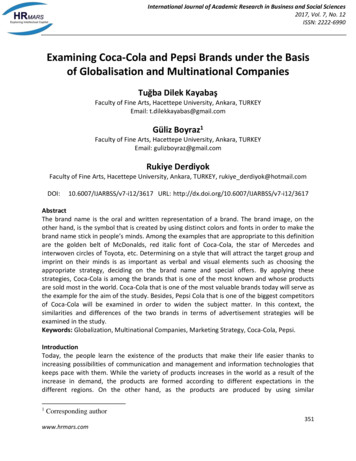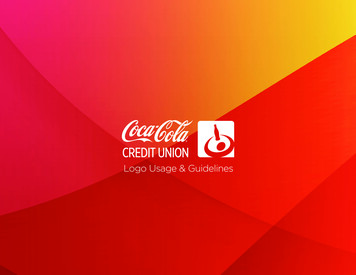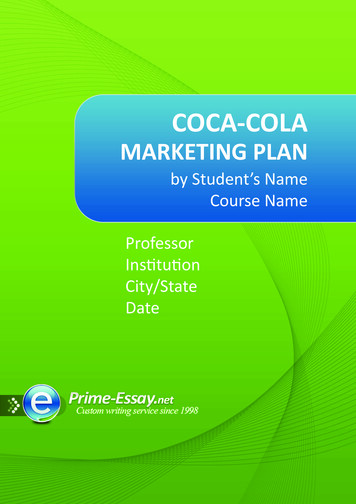
Transcription
COCA-COLAMARKETING PLANby Student’s NameCourse NameProfessorIns tu onCity/StateDate
COCA COLA MARKETING PLANIntroduc onIn the last decades, the level of compe on among various firms has dras cally surged. This is caused by the increased level of technological knowhowand reduced barriers to entry for businesses, as well as the increased popula on, which provides the required market for produced goods and services.Benson (2010) argues that an improvement in technology has contributed tothe success of small businesses for the last five years, as they can compete onthe same pla orm with big and well-established companies. For example,small companies, especially in developing countries, have embraced onlinemarke ng strategies for their goods. This way, they managed to increase theirmarket share despite them lacking adequate capital to establish physicalshops in certain geographical areas around the world. One such company,which has remained a market leader despite heavy compe on in the industry, is the Coca-Cola Company. Established in late 19th century, it is the largestcompany in based on producing, distribu ng and selling of non-alcoholic beverages globally. The company operates in more than 200 countries and hasdeveloped more than 400 brands since its incep on. Some of the famousbrands sold by the company include Coke, Sprite, and Stony among others. Itis clear that the firm has successfully kept compe tors, such as Nestle, PepsiCo and others, at a bay because of various marke ng strategies employedby the company. This paper seeks to cri cally analyse and evaluate Coca-ColaCompany marke ng plans, which have ul mately made it remain a marketleader in the non-alcoholic beverages industry.Company BackgroundThe Coca-Cola Company is the leading company as far as manufacturing, distribu ng, and selling non-alcoholic beverages in the U.S. and other parts ofthe world are concerned. The company was established in 1886, in AtlantaGeorgia by John Pemberton, who was a pharmacist, and combined sodawater, shrub weeds from Brazil, cinnamon and lime water. These ingredientsformed an original recipe of non-alcoholic beverages, which became themost consumed across the globe. The recipe was later purchased by AsaCOCA COLA MARKETING PLAN2
Chandler in 1891 at a value of US 2300, thus, turning Coca-Cola into a globally renowned brand, as it is in the present mes. The Coca Cola Companymanufactures and sells more than 400 brands of products across the world,making it the leading company in terms of market shares, which are at least45%, and enjoys customers’ loyalty of approximately 90% as per 2010. TheCoca-Cola Company has branches in more than 200 countries and operatesthrough licensed independent distributors in these countries. This is anaspect that helps the company cri cally segment its customers, resul ng intohigh profitability levels. Despite harsh economic mes, which faced manycompanies across the world, the Coca-Cola Company remained profitablethroughout this period. This is because of its ability to embrace new modernmarke ng strategies, such as the use of the social media, such as Twi er,Facebook, MySpace, among other notable forms of modern marke ng,namely blogs and mini websites. Over the years, the company has been ableto keep a reputable philanthropic history ranging from construc ng wildlifepreserves in such places as Ossabaw Island to sponsoring the FIFA 2010World Cup held in South Africa. These aspects combined with innova on andinven ons cons tute a corporate culture that has catapulted the Coca-ColaCompany to be one of the best performing companies (Benson, 2010).VisionThe company’s vision 2020 aims at crea ng sustainable long-term des na ons for the business through the provision of roadmaps for a win-win situa on for the firm and all its partners.MissionThe mission declares the purpose of the company. It also serves as a standard, against which the Coca-Cola Company weighs its decisions and ac ons.The company has three main mission statements, which are as follows:1) Refreshing the world;2) Crea ng value and making a difference;3) Inspiring moments for happiness and op mism.COCA COLA MARKETING PLAN3
VisionThe vision of the company serves as a framework, which guides each area ofthe business through describing what is required to accomplish sustainablequality growth in the short- and long-run. This falls under “6Ps” policies indicated below:1) PEOPLE: the Company aims to be a great place to work, wherepeople are fully inspired, being the best they can.2) PARTNERS: the Coca-Cola Company has a strong winning networkcomposed of suppliers and customers. This way, they createenduring values and mutual responsibility.3) PORTFOLIO: the organiza on produces the best beverage brandsacross the world, sa sfying people’s needs and desires.4) PRODUCTIVITY: its aim is to be lean, highly effec ve and a fastmoving organiza on.5) PROFIT: the company aims at maximizing long-term returns toshareholders, while carefully being mindful of the firm’s overallresponsibility.6) PLANET: it aims to be a responsible corporate, who makes adifference by helping in suppor ng and building sustainablecommuni es.[.]Compe ve ReviewDespite having a market share of over 50%, it is evident that the Coca-ColaCompany faces a s ff compe on from various well-established beveragecompanies across the globe. Since 2008, the stocks of Coca-Cola have beenon a gradual increase as compared to those of the main compe tor PepsiCo.For example, PepsiCo share prices have increased to US 63.56 up fromUS 45.78 in 2008. During this period, Coca-Cola shares have increased fromUS 52.35 in 2008 up to US 65.39 (Coca Cola Company, 2012). A quickincrease in share values of PepsiCo, as compared to that of Coca-Cola, can becaused by the diversifica on of PepsiCo products. A er the acquisi on of theCOCA COLA MARKETING PLAN4
South Beach Company, the company has diversified its products to noncarbonated beverages, such as Gatorade sport drinks and herb spirited fruitsamong other products (Webster, 2009). This factor has increased investors’confidence because of brighter market prospects facing PepsiCo. Anotherclose compe tor of Coca-Cola is FIZ (a Na onal Beverage Company), whichoperates in the North American region, being Coca-Cola’s main stronghold.The company manufactures dis nct flavours, such as Faygo, Shasta, and Flagship brands, which heavily compete with Coca-Cola so drinks. CadburySchweppes and all its subsidiary products also offer a s ff compe on to theCola Company, especially in the Asian and African markets. The group focuseson the beverages business, managing extensive brand por olios. The Co Corpora on, which operates in the U.S., manufactures and sells organic beverages, bo led water and iced tea, also offering a s ff compe on to theCoca-Cola Company (Gupta, 2010). The company has subsidiaries in Canadathrough the BBC USA Corpora on. It is clear that the Coca-Cola Companyfaces strong compe on from these and other emerging companies. Thisnecessitates the need for con nuous market research to enable innova onand inven on, and come up with products that will sa sfy customers’ needsglobally now and in the future.BCG MatrixCOCA COLA MARKETING PLAN5
ConclusionFor a company to perform well in the interna onal market, such aspects asmarke ng segmenta on, con nuous market research, and market mixorganisa onal structures should be clearly analyzed. It is clear that the CocaCola Company remains one of the best performing companies in the nonalcoholic beverages industry despite heavy compe on in this sector. This isclearly indicated by high sales revenues of US 35.119 billion posted in 2010.The company’s share value has also been on an increase, resul ng into animprovement in investor’s confidence across the globe. In general, the CocaCola Company should invest in such areas as organic products in order tocater for changing consumer lifestyles in such areas as the U.S., Europe andLa n America.BibliographyBenson, D 2010, Coca Kick In Drinks Spurs Sales Raises. Pearson Educa on publishers, California.Ghemawat, P.2007, Redefining Global Strategy: Crossing Borders In A World Where DifferencesStill Matter. Harvard University Press, California.Goldstein, D 2007, what is Customer Segmentation. Wharton School Publishing, New York.Gupta, S 2010, Managing Customers as Investments: The Strategic Value of Customers in the LongRun. Pearson Educa on publishers, Upper Saddle River.Hi , M & Ireland, R 2008, Understanding Business Strategy: Concepts and Cases. Cengage Learning, London.Hong, C 2009, The spermicidal potency of Coca-Cola and Pepsi-Cola. Human Toxicology. Macmillan Publishers, London.Kotler, P & Armstrong, G 2010, Marketing: An Introduction. Pearson, London.Murden, T 2010, Coke Adds Life To Health Drinks Sector. Oxford University Press, Scotland.The Coca Cola Company 2012, Annual & other Report. Retrieved From,h p://www.thecoca-colacompany.com/investors/annual other reports.htmlh p://en.wikipedia.org/wiki/Industrial market segmenta on - cite ref-0Webster, F. 2009, Industrial Marketing. John Wiley & Sons , London.COCA COLA MARKETING PLAN6
COCA COLA MARKETING PLAN 3 Chandler in 1891 at a value of US 2300, thus, turning Coca-Cola into a glob-ally renowned brand, as it is in the present mes. The Coca Cola Company manufactures and sells more than 400 brands of products across the world, making it the leading company in terms of market shares, which are at least
